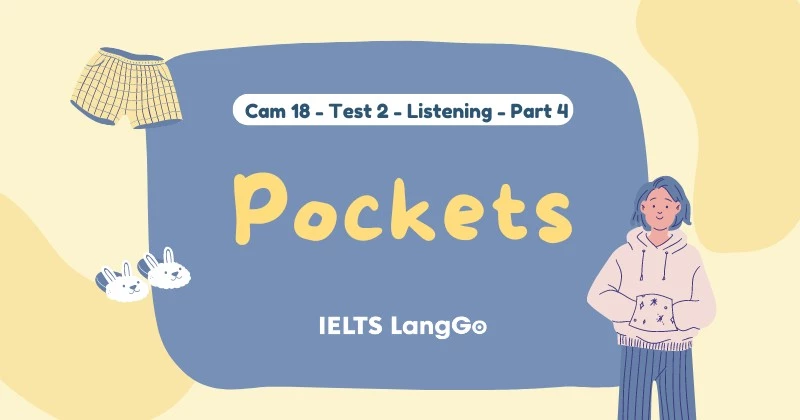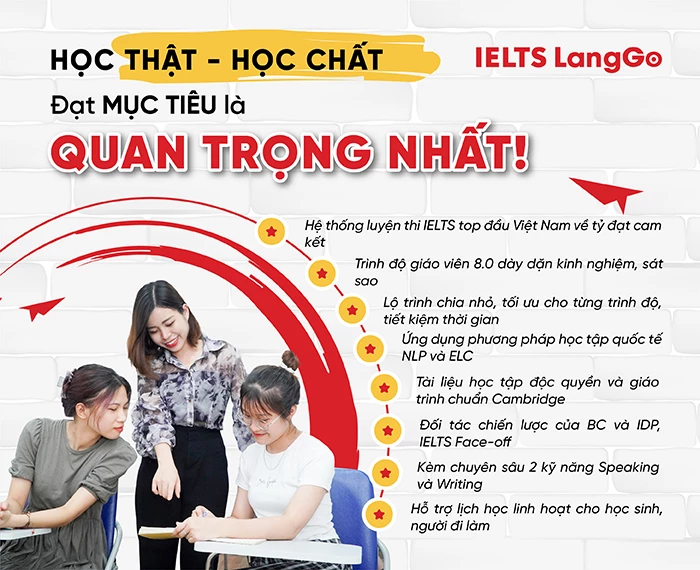


Ngày hôm nay, IELTS LangGo sẽ mang lại cho các bạn phần bài tập và giải thích chi tiết đáp án bài Listening IELTS: Pockets. Các bạn hãy làm bài thật cẩn thận trước khi tham khảo transcript và phần đáp án để có thể đánh giá chính xác nhất khả năng của mình nhé!
Questions 31-40
Complete the notes below.
Write ONE WORD ONLY for each answer.
Pockets
Reason for choice of subject
Pockets in men’s clothes
Pockets in women’s clothes
Phân tích đề bài và chiến lược làm bài:
Bài tập này bao gồm 10 câu, thuộc dạng Note Completion
Chiến lược làm bài dạng Note Completion:
B1: Đọc kỹ câu hỏi để xác định số từ được phép viết vào chỗ trống và tiêu đề.
B2: Dự đoán loại từ & thông tin cần diền.
B3: Chú ý keywords, các từ đồng nghĩa, paraphrase và những từ ngữ gây phân tâm.
B4: Trả lời câu hỏi theo thứ tự.
B5: Kiểm tra thật kỹ ngữ pháp và chính tả bằng cách đọc lại cả câu sau khi điền đáp án.
Trong bước check transcript, các bạn hãy kết hợp với việc tìm tòi các từ vựng mới, cũng như nghe audio một lần nữa để học được cách phát âm các từ thật chính xác nhé!
Dưới đây là đáp án của đề Cambridge 18 Listening Test 2 Part 4: Pockets
| 31 | convenient | 36 | string(s) |
| 32 | suits | 37 | waist(s) |
| 33 | tailor | 38 | perfume |
| 34 | profession | 39 | image |
| 35 | visible | 40 | handbag |

Question 31:
Đáp án: convenient
Keywords câu hỏi: They are 31_____ but can be overlooked by consumers and designers.
Thông tin cần tìm: Tính từ chỉ đặc điểm của những chiếc túi
Keywords trong bài nghe: I decided to focus on a rather small area of clothing and that’s pockets. I chose pockets for two reasons, really […] nothing is quite as convenient as being able to pop your phone or credit card into your pocket. Yet, I suspect that, other than that, people don’t really think about pockets too much and they’re rather overlooked as a fashion item.
Giải thích: Người nói nêu lên lý do chọn chủ đề về túi (I chose pockets for two reasons) do chúng khá tiện lợi (nothing is quite as convenient) và thường là một chi tiết thời trang bị ngó lơ (they’re rather overlooked as a fashion item.)
Question 32:
Đáp án: suits
Keywords câu hỏi: Men started to wear 32_____ in the 18th century.
Thông tin cần tìm: danh từ chỉ một trang phục đàn ông mặc từ thế kỷ 18.
Keywords bài nghe: In the 18th century, fashions were quite different from the way they are now, and pockets were too. If we think about male fashion first […] that was the time when suits became popular.
Giải thích: Vào thế kỷ 18 (In the 18th century), khi nhắc đến thời trang nam (If we think about male fashion first), đó là khoảng thời gian những bộ com lê trở nên phổ biển (that was the time when suits became popular)
Question 33:
Đáp án: tailor
Keywords trong câu hỏi: A 33 _____ sewed pockets into the lining of the garments.
Thông tin cần tìm: danh từ chỉ người đã may những chiếc túi vào lớp lót.
Keywords bài nghe: Trousers were knee-length only and referred to as ‘breeches’, the waistcoats were short and the jackets were long, but all three garments were lined with material and pockets were sewn into this cloth by whichever tailor the customer used.
Giải thích: Cả 3 loại trang phục đều được lót bằng chất liệu may (all three garments were lined with material), những chiếc túi sẽ được may vào lớp lót bởi người thợ may (pockets were sewn into this cloth by whichever tailor).
Question 34:
Đáp án: profession
Keywords câu hỏi:
- The wearer could use the pockets for small items.
- Bigger pockets might be made for men who belonged to a certain type of 34 _____
Thông tin cần tìm: Danh từ - chỉ đặc điểm chung của một nhóm đàn ông
Keywords bài nghe: The wearer could then carry small objects such as pencils or coins on their person and reach them through a gap in the lining. Coat pockets […] were often larger but plainer if the wearer was someone with a profession who needed to carry medical instruments – a doctor or physician, for example.
Giải thích: Những chiếc túi trong áo khoác thường lớn hơn nhưng đơn giản hơn (Coat pockets […] were often larger but plainer) nếu người mặc là người có chuyên môn cần mang theo dụng cụ y tế… (if the wearer was someone with a profession who needed to carry medical instruments)
Question 35:
Đáp án: visible
Keywords câu hỏi: Women’s pockets were less 35 _____ than men’s.
Thông tin cần tìm: Tính từ - chỉ một tính chất được so sánh giữa túi của nam và nữ.
Keywords bài nghe: The development of women’s pockets was a little different. For one thing, they weren’t nearly as visible or as easy to reach as men’s.
Giải thích: Túi ở trang phục của nữ không dễ thấy hay dễ tiếp cận như của nam. (they weren’t nearly as visible or as easy to reach as men’s.) - Ở đây có 2 ý: “visible” & “easy to reach”, tuy nhiên đề bài yêu cầu chỉ điền 1 từ.
Question 36:
Đáp án: string
Keywords câu hỏi:
- Women were very concerned about pickpockets.
- Pockets were produced in pairs using 36 _____ to link them together.
Thông tin cần tìm: danh từ chỉ vật được dùng để kết nối 2 chiếc túi.
Keywords bài nghe: Women were more vulnerable to theft and wealthy women, in particular, worried constantly about pickpockets. So – what they did was to have a pair of pockets made that were tied together with string.
Giải thích: Họ đã tạo ra một cặp túi được kết nối bởi một sợi dây (what they did was to have a pair of pockets made that were tied together with string.)
Question 37:
Đáp án: waist
Keywords câu hỏi: Pockets hung from the women’s 37 _____ under skirts and petticoats.
Thông tin cần tìm: danh từ chỉ bộ phận của nữ.
Keywords trong bài nghe: Women tied the pockets around their waist so that they hung beneath their clothes.
Giải thích: Những người phụ nữ buộc túi dưới eo (Women tied the pockets around their waist) để chúng nằm dưới quần áo của họ.
Question 38:
Đáp án: perfume
Keywords câu hỏi: Items such as 38 _____ could be reached through a gap in the material.
Thông tin cần tìm: danh từ chỉ đồ vật có thể được lấy qua một lổ hỏng trên vải.
Keywords bài nghe: They would have an opening in the folds of their skirts through which they could reach whatever they needed, like their perfume.
Giải thích: Có một lỗ hổng trong các nếp gấp trên váy (They would have an opening in the folds of their skirts), nơi họ có thể với qua và lấy (through which they could reach) vật dụng như nước hoa (their perfume).
Question 39:
Đáp án: image
Keywords câu hỏi: When dresses changed shape, hidden pockets had a negative effect on the 39 _____ of women.
Thông tin cần tìm: danh từ chỉ một khía cạnh của phụ nữ bị ảnh hưởng một cách tiêu cực.
Keywords bài nghe: … when dresses became tighter and less bulky, and the pairs of pockets became very noticeable – they stood out too much and detracted from the woman’s image.
Giải thích: Khi váy trở nên chật và bớt cồng kềnh hơn (when dresses became tighter and less bulky), cặp túi làm xấu đi hình ảnh của người phụ nữ. (the pairs of pockets […] detracted from the woman’s image)
Question 40:
Đáp án: handbag
Keywords câu hỏi: Bags called ‘pouches’ became popular, before women carried a 40 _____.
Keywords bài nghe: That was when small bags, or pouches as they were known, came into fashion and, of course, they inevitably led on to the handbag of more modern times, particularly when fashion removed pockets altogether.
Giải thích: Khi những chiếc túi nhỏ được gọi là ‘pouches’ trở nên phổ biến (when small bags, or pouches as they were known, came into fashion), chúng dẫn đến sự phát triển của chiếc túi xách ở giai đoạn hiện đại hơn (led on to the handbag of more modern times).
Hãy tham khảo kỹ phần transcript sau đây, đặc biệt là những phần bạn không nghe rõ và luyện nghe lại nhiều lần để tiến bộ hơn nhé:
| Good morning. Now, we’ve been asked to choose an aspect of European clothing or fashion and to talk about its development over time. I decided to focus on a rather small area of clothing and that’s pockets. I chose pockets for two reasons, really. We all have them – in jeans, jackets, coats, for example – and even though we often carry bags or briefcases as well, nothing is quite as convenient as being able to pop your phone or credit card into your pocket(31). Yet, I suspect that, other than that, people don’t really think about pockets too much and they’re rather overlooked as a fashion item. It’s certainly very interesting to go back in time and see how pockets developed for men and women. In the 18th century, fashions were quite different from the way they are now, and pockets were too. If we think about male fashion first … that was the time when suits became popular(32). Trousers were knee-length only and referred to as ‘breeches’, the waistcoats were short and the jackets were long, but all three garments were lined with material and pockets were sewn into this cloth by whichever tailor the customer used. (33) The wearer could then carry small objects such as pencils or coins on their person and reach them through a gap in the lining. Coat pockets became increasingly decorative on the outside for men who wanted to look stylish, but they were often larger but plainer if the wearer was someone with a profession who needed to carry medical instruments – a doctor or physician, for example. (34) —— The development of women’s pockets was a little different. For one thing, they weren’t nearly as visible or as easy to reach as men’s. (35) In the 18th and 19th centuries, women carried numerous possessions on their person and some of these could be worth a lot of money. Women were more vulnerable to theft and wealthy women, in particular, worried constantly about pickpockets. So – what they did was to have a pair of pockets made that were tied together with string. (36) The pockets were made of fabric, which might be recycled cloth if the wearer had little money or something more expensive, such as linen, sometimes featuring very delicate embroidery. Women tied the pockets around their waist so that they hung beneath their clothes. (37) Remember, skirts were long then and there was plenty of room to hide a whole range of small possessions between the layers of petticoats that were commonly worn. They would have an opening in the folds of their skirts through which they could reach whatever they needed, like their perfume. (38) Working women, of course, also needed to carry around items that they might use for whatever job or trade they were involved in, but their pairs of pockets still remained on the inside of their clothing, they just got bigger or longer sometimes reaching down to their knees! So the tie-on pockets went well into the 19th century and only changed when fashion altered towards the end of that period. That’s when dresses became tighter and less bulky, and the pairs of pockets became very noticeable – they stood out too much and detracted from the woman’s image. (39) Women who had been used to carrying around a range of personal possessions – and still wanted to – needed somewhere to carry these items about their person. That was when small bags, or pouches as they were known, came into fashion and, of course, they inevitably led on to the handbag of more modern times, particularly when fashion removed pockets altogether. (40) |
LangGo IELTS hy vọng với bài viết giải Cam 18 - Listening Test 2 part 4: Pockets, các bạn đã trau dồi được nhiều kiến thức mới về từ vựng, phát âm, nghe hiểu cũng như kỹ năng làm các bài dạng Note Completion. Mục tiêu IELTS của các bạn đang ngày càng tiến gần hơn sau mỗi lần luyện tập. Chúc các bạn thành công!



ĐẶT LỊCH TƯ VẤN MIỄN PHÍ LỘ TRÌNH Săn ƯU ĐÃI lên tới 12.000.000đ